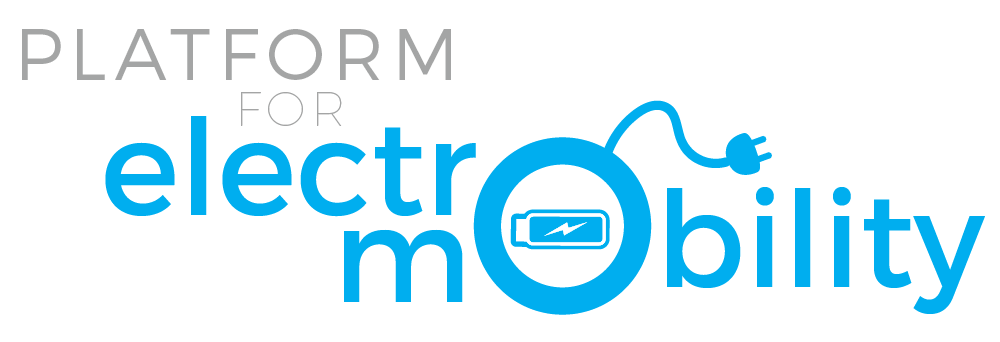[Video] Peter Badik (GreenWay) on Electricity Market Design
Electricity Market Design
Peter Badik, CEO of GreenWay, on the importance of the reform of the Electricity Market Design.
The Platform for electromobility, uniting industries, civil society organisations and cities from the transport, energy and clean tech sector, welcomes the Electricity Market Reform (EMD) proposal as an important opportunity to support the build-out of grid-friendly e-mobility across Europe. We appreciate the proposals improve the existing electricity market framework in a way that facilitates cost-effective deployment of individual or aggregated smart and bidirectional electric vehicles (EVs) charging. As the EV market is growing rapidly, smart and bidirectional charging will quickly become one of the most important sources of demand-side flexibility. In the collective European effort to decrease fossil gas imports, EV charging flexibility will be instrumental to reduce consumer costs, greenhouse gas emissions and better integrate solar and wind in the grid. Importantly, by offering additional revenues or cost saving opportunities to EV owners, the reform accelerates EV take-up and the clean transport transition.
The Platform therefore urges co-legislators to keep the level of ambition and a swift adoption. The European Commission’s EMD reform proposal supports the uptake of e-mobility in the following ways:
The reform recognises EVs as flexibility resource
Member States will have to make a detailed assessment of the needs and the potential of demand-side response and storage. Based on the assessment, an indicative objective shall be set and supportive measures, such as a flexibility support scheme, may be introduced. It is important to properly include EVs as a source of demand response and storage in both the assessment of the flexibility needs and the objective for demand response and storage, and ensure appropriate participation of EV stakeholders in these assessments processes.
The reform further supports the participation of EVs in the markets
The threshold for participation in the day ahead and intraday markets get lowered to 100 kW, which makes them more accessible to aggregations of EV fleets. This will help develop the market for user-centric smart and bidirectional charging services. It may be advisable to extend this lower threshold also to capacity markets.
The reform accelerates planning for EV charging infrastructure
Transmission and distribution system operators will be financially incentivized to fully consider local demand side resources, such as EVs, when looking for solutions for grid congestion. System operators will propose further transparency and proactivity on their planning for connecting EV charging infrastructure, for example by sharing hosting capacity available for EV charging. This is essential information for providers of EV charging services and helps accelerate grid-efficient build-out of EV charging infrastructure.
Greening Corporate Fleets Initiative: support to the launch of a public consultation
The Platform for electromobility supports the launch of a public consultation on the Greening Corporate Fleets Initiative .
The members of the Platform for electromobility, a leading advocate for sustainable mobility and environmental development, hereby publicly expresses their strong support for the Greening Corporate Fleets Initiative included in the European Commission’s work program for 2023 and called for by the European Parliament in May 2022.
We understand that it will be difficult to launch and complete this initiative before the end of the Commission’s mandate in 2024. We would however very positively welcome the launch of a public consultation on this very important topic to collect as much data and information to guarantee the success of such an initiative at a later date.
The Greening Corporate Fleets Initiative represents a vital step toward accelerating the transition to electric mobility, ensuring a sustainable future for both our environment and society. By calling for a comprehensive framework for corporate fleet emissions reduction, this initiative aligns with our previous policy recommendations on the matter (the reasons, the concerns and the methods). We firmly believe that it presents an excellent opportunity to drive meaningful change while safeguarding the interests of the most modest individuals who should not bear the sole burden of the transition.
The environmental benefits of the Greening Corporate Fleets Initiative cannot be overstated. By incentivizing and supporting the adoption of electric vehicles across corporate fleets which are now electrifying slower than private vehicles[1], we can significantly reduce greenhouse gas emissions and limit the impacts of transportation on our climate. This aligns with the ambitious climate targets set forth in the European Green Deal.
Furthermore, the social aspect of this initiative should not be overlooked. By focusing on corporate fleets, the Greening Corporate Fleets Initiative ensures a fair distribution of the costs associated with the transition to greener mobility solutions. As stated above, by shouldering a portion of the burden, corporations can contribute to building a more sustainable future while least-well-off families are not unduly burdened by the costs of this transition.
Moreover, the initiative’s emphasis on creating a robust second-hand market for electric vehicles is commendable. A thriving secondary market for EVs will not only enhance the affordability of these vehicles but also encourage the wider adoption of clean transport solutions. By stimulating the circular economy, this initiative will unlock significant economic and environmental benefits.
In conclusion, the Platform supports the Greening Corporate Fleets Initiative and encourages DG MOVE to promptly initiate a public consultation on this crucial matter. We believe that by working collaboratively, policymakers, industry stakeholders, and citizens can co-create a sustainable mobility landscape that fosters environmental stewardship, social equity, and economic growth.
[1] https://www.transportenvironment.org/wp-content/uploads/2023/05/Briefing-on-Fleets-Regulation-3.pdf
Weights & Dimensions Directive: ACEA, Platform for electromobility and Hydrogen Europe call it a priority in a joint letter
Open letter
Calling co-legislators for swift progress on the revision of the Weight and Dimensions Directive
To European Commission Executive Vice-President for the European Green Deal, Frans Timmermans
To the European Commissioner for Transport, Adina-Ioana Vălean
To Ambassador and Permanent Representative of Spain to the European Union, D. Marcos Alonso Alonso
To the Presidents of the TRAN and ENVI Committees of the European Parliament, Karima Delli and Pascal Canfin
To the Presidents of the European Parliament Political Groups,
Dear,
We, the undersigned representatives from the European Automobile Manufacturers’ Association (ACEA), the Platform for electromobility and Hydrogen Europe, representing the majority of industry stakeholders and civil society in vehicle manufacturing, direct electrification and hydrogen value chain, are writing to highlight the crucial role of establishing a full set of enabling conditions to support the transition of the European road transport industry to climate neutrality by 2050. The Review of the Weights & Dimensions (W&D) Directive is one crucial element of the regulatory framework to facilitate the market uptake of zero-emission, battery-electric and hydrogen-powered trucks and buses. We are concerned that any further delays and persistent uncertainty surrounding a timely adoption and implementation of a revised Weights and Dimensions Directive would be detrimental to our joint climate neutrality ambition and the EU target of 90% transport emission reduction by 2050.
Zero-emission vehicles (ZEVs) will have to become the backbone of road transport if the sector is to reach its decarbonisation targets. Zero-emission vehicles (ZEVs) come with additional requirements with respect to available space in the vehicles, total vehicle weight and axle weights. These ddifferences to vehicles powered by fossil fuels should be addressed in the review with an aim to remove any barriers that can hinder their market uptake and firmly place them on a level playing field with vehicles powered by fossil fuels.
The Review should specifically:
- Simplify the Directive as much as possible and ensure a fully harmonized implementation in Member States
- Provide additional weight allowances for zero-emission vehicles and adjust the provisions for axle weights and vehicle length to accommodate the requirements of zero-emission powertrains.
- Ensure intermodal compatibility in the revision of the Weights & Dimensions Directive.
The Weights & Dimensions Directive must be seen as a key enabler of the transition to climate neutrality and should as such also be acknowledged by the co-legislators.
ACEA, the Platform for electromobility, and Hydrogen Europe are united in calling on the European institutions, namely the European Commission, the incoming Spanish Council Presidency, the European Parliament and EU Member States to prioritize making the necessary adjustments in the Weights & Dimensions framework. It is imperative that progress is made swiftly to remove barriers in the Weights & Dimensions framework that may hinder the market adoption of zero-emission trucks and buses.
We trust that you share our sense of urgency and will take the necessary steps to ensure that Europe establishes a coherent and supportive regulatory framework to enable the swift decarbonisation of road transport and seizes the opportunities provided by sustainable mobility.
Sincerely,
Our statement on the reform of the Electricity Market Design
Electricity Market Design
The Platform for electromobility urges ambitious adoption of EMD reform to drive grid-friendly e-mobility
The Platform for electromobility, uniting industries, civil society organisations and cities from the transport, energy and clean tech sector, welcomes the Electricity Market Reform (EMD) proposal as an important opportunity to support the build-out of grid-friendly e-mobility across Europe. We appreciate the proposals improve the existing electricity market framework in a way that facilitates cost-effective deployment of individual or aggregated smart and bidirectional electric vehicles (EVs) charging. As the EV market is growing rapidly, smart and bidirectional charging will quickly become one of the most important sources of demand-side flexibility. In the collective European effort to decrease fossil gas imports, EV charging flexibility will be instrumental to reduce consumer costs, greenhouse gas emissions and better integrate solar and wind in the grid. Importantly, by offering additional revenues or cost saving opportunities to EV owners, the reform accelerates EV take-up and the clean transport transition.
The Platform therefore urges co-legislators to keep the level of ambition and a swift adoption. The European Commission’s EMD reform proposal supports the uptake of e-mobility in the following ways:
The reform recognises EVs as flexibility resource
Member States will have to make a detailed assessment of the needs and the potential of demand-side response and storage. Based on the assessment, an indicative objective shall be set and supportive measures, such as a flexibility support scheme, may be introduced. It is important to properly include EVs as a source of demand response and storage in both the assessment of the flexibility needs and the objective for demand response and storage, and ensure appropriate participation of EV stakeholders in these assessments processes.
The reform further supports the participation of EVs in the markets
The threshold for participation in the day ahead and intraday markets get lowered to 100 kW, which makes them more accessible to aggregations of EV fleets. This will help develop the market for user-centric smart and bidirectional charging services. It may be advisable to extend this lower threshold also to capacity markets.
The reform accelerates planning for EV charging infrastructure
Transmission and distribution system operators will be financially incentivized to fully consider local demand side resources, such as EVs, when looking for solutions for grid congestion. System operators will propose further transparency and proactivity on their planning for connecting EV charging infrastructure, for example by sharing hosting capacity available for EV charging. This is essential information for providers of EV charging services and helps accelerate grid-efficient build-out of EV charging infrastructure.
[Video] Matteo Barisione (UNIFE) on Net Zero Industrial Act
Net Zero Industrial Act
Explained by Matteo Barisione, UNIFE
The Net Zero Industry Act, a mere response to the U.S. IRA?
Matteo: Yes and No. The Commission’s proposal goes beyond a mere response to the American Inflation Reduction Act. It is an accelerator for clean tech using regulatory rather than financial measures. And the Platform really sees the proposal as an enabler for a competitive transition to electric mobility.
But in its scope, the Net Zero Industry Act mirrors the IRA too much. It needs to consider European transport system specificities and the whole value chain of e-mobility.
Third screen: How to improve the Net Zero Industry Act?
Matteo: Although we welcome the inclusion of batteries, charging infrastructures and grid technologies as Strategic Net Zero Technologies, we remain concerned about the lack of recognition of the entire electric mobility value chain: Net Zero Technologies should extend to include other EV-enabling technologies like V2G component manufacturers, and – as you can see we chose to talk today from a rail station – all zero-emission modes.
Forth screen: Extending the scope at the expense of existing sectors?
Matteo: Because the Act is a regulatory tool, not a financial one, extending its scope does not take anything away from the sectors already included.
In recent position papers, we detailed the financial and non-financial measures the co-legislators should bring up to make this industrial act truly European – so do go check it out!
[Video] Giovanni Matranga (ENEL Group) explains the CO2 Standards for HDVs
CO2 Standards for HDVs
Explained by Giovanni Matranga, chair of WG Logistics & buses
Is the CO2 Standards for HDV ambitious enough?
Givoanni: CO2 Standards are a crucial piece of legislation to make sure that heavy road transport will make its part to the achievement of the EU climate goals. New standards are undoubtedly needed to set the right pace and a clear trajectory for everyone: manufacturers, logistics operators and the whole supply chain.
For us the platform, considering the average lifespan of a truck of roughly 15 years, it’s imperative to respect climate goals that almost all newly registered trucks should be 100% zero emission by 2035.
Regarding urban buses, we welcome the Commission’s strong ambition, although some improvements must be performed for a proper transition to zero-emission buses in cities.
What about the new definition of zero-emission vehicle?
Giovanni: I am sorry that I may be a bit technical here, but a key point is the new definition of “zero-emission vehicle”, that would consider trucks and buses emitting 5 grams of CO2 per tonne-kilometer as zero-emission vehicles. In our platform view, this could create a dangerous loophole and allow the sales of polluting vehicles even after 2050 and lead to greenwashing practises.
How to know more?
Giovanni: If you are still watching this video, I have good news for you. On the 23rd of May, Members of the European Parliament, the European Commission and representatives of the trucks and buses industries will gather in a policy conference organised by the Platform for electromobility. Don’t miss your chance to participate in the discussion by registering on our website.
The reactions from the electric mobility ecosystem on Net Zero Industry Act
Green Deal Industrial Plan:
the reactions from the electric mobility ecosystem on Net Zero Industry Act and State Aid framework.
The Platform for electromobility welcomes the European Commission’s Net Zero Industrial Act (NZIA) and Temporary Crisis and Transition State aid Framework (TCTF) for accelerating the transition of the EU’s net zero industrial sectors towards climate neutrality by 2050. As currently proposed, the NZIA is a positive start for a necessary holistic and long-term strategic plan, detailing specific financial and regulatory support measures for addressing all global current and future challenges, securing an EU-built industrial ecosystem of sustainable transport and ensuring bespoke strategic autonomy for every key sector identified.
We understand and welcome the package of both NZIA and TCTF as a tool for accelerating clean-tech industries with proposed non-financial regulatory measures. In this paper, we outline how the narrow scope of the proposed NZIA may fail in its aim of supporting European specificities. In addition, certain financial measures should also be included; without these, the NZIA may fall short of achieving its intended goals and fail to provide the required support for European clean industries.
Scope
Given the importance of reducing greenhouse gas emissions from the transport sector and industries, and the fact that Europe’s transport systems make up part of its critical infrastructure, we consider that mobility industries that provide zero-emission vehicles (ZEV) – all transport modes considered – as well as charging stations, software and other ZEV enabling tech, should be considered part of the ‘Clean Tech’ sector.
We welcome the inclusion of battery, charging infrastructures and grid technologies in the Annexes as Strategic Net Zero Technologies, yet we remain concerned about the lack of recognition for the entire EV value chain in the proposal. Net Zero Technologies should be extended to include other EV enabling technologies, including smart and bidirectional charging as well as component manufacturers.
A more flexible approach to those sectors that will be key for the EU’s future competitiveness should be adopted. Downstream industries, such as ZEV manufacturers, should be better considered and included in the scope of the Regulation to secure economic opportunities for supported upstream industries, such as cell manufacturing. Considering the NZIA as a non-financial tool, extending the scope to other sectors of the energy transition would increase Europe’s ability to be competitive in strategic sectors for the decarbonisation of transport, without undermining the support of already-included sectors such as battery manufacturing.
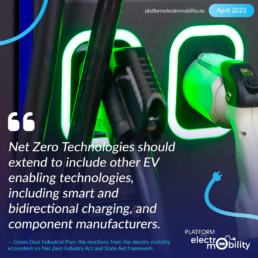
Non-financial measures
To create the enabling conditions for the European clean transport industry to prosper, several issues must be urgently tackled.
The Green Deal is the EU’s centrepiece climate policy. It is now necessary to provide the regulatory certainty for businesses that will allow them to invest in the transition of the EU economy to a sustainable model that is consistent with the 2050 target of climate neutrality. Europe should lock-in ambitious Green Deal Fit for 55 policies (including the Trans-European Network for Transport Guidelines revision, the 2035 zero-emission objective for new cars and vans) and introduce similar policies for trucks and non-road mobile machinery in order to phase-out fossil trucks between 2035-40.
As specified in the proposal, and in order to ensure regulatory certainty, it is important that Member States endorse and adopt legislative and non-legislative actions relating to the Green Deal Industrial Plan. Such actions should be incorporated into national planning processes and should prioritise clean industries in energy and climate plans. New measures should also align with existing governance regulations and contribute to national energy and climate goals. National Recovery Resilience Plans should address the new elements from upcoming regulations, and the ways in which clean value chains can support energy and climate targets.
For the forthcoming mid-term revision of the Multiannual Financial Framework, we welcome recent guidelines pushing Member States to amend National Recovery and Resilience Plans towards energy independency via renewable energy deployment and greening industries. Given the strong synergies between renewable energies and electric mobility, the former will inevitably form a key pillar of a European sustainable, electric transportation system.
We welcome NZIA’s measures for reducing unwieldy bureaucracy and speeding up overly cumbersome and slow procedures for the granting of permits, through national single points of contacts and maximum durations for permitting procedures. The ‘regulatory sandbox’ approach for new technologies can also help support their faster market readiness.
More could be done, however, through a critical review of the sectoral regulation applicable to existing zero-emission industries or technologies, to accelerate product development, capacity for sustainably extracted raw materials and renewable energy, validation, certification and market access, wherever possible. Sectoral action plans could draw on the Mobility Ecosystem Transition Pathway released by the Commission in March 2022.
In order to fast-track best-in-class projects, we welcome that Member States will be required to appoint a contact person for net zero strategic projects.
For modernisation, more should be done to digitalise the approvals process and to increase expertise and skills in local and national authorities.

The Platform supports provisions oriented towards a more binding approach to sustainability / Most-Economic Advantageous Tender (MEAT). The NZIA proposes specific sustainability and resilience criteria that public authorities need to take into account during public procurement procedures, in addition to price or cost. Public authorities shall give the tender’s sustainability and resilience contribution a weight of between 15% and 30% of the award criteria. This goes beyond the only price criteria, and is aligned with the MEAT principle, which is of great importance for the transport sector.
The question of which criteria for which technology should not be tackled in great detail within the NZIA, but rather in some upcoming guidelines from the European Commission. These would support public procurement authorities grasping sustainability and resilience criteria.
In the longer term, improved coordination between universities and industries on European research strategies and priorities is essential: Europe is home of many leading research institutes, but the research sector is overly fragmented to be able to outperform some global regions in the race to develop clean tech. The role of Horizon Europe and of Public-Private Partnerships should be reinforced to address this. European research institutes are also vital in equipping the European workforce with necessary skills for the transition.
The introduction of Net Zero Academies in the NZIA goes in the right direction, but these would require more details and specification. For example, the United States’ IRA has conditionality measures to link public support with social policies at company level. The EU should support companies in their commitment for upskilling and reskilling their workforce. It should foster and promote synergies between public and private sectors, in order to create training programmes fit for the net-zero value chain, such as the ReKnow University.
Financial measures
We welcome the simplification of EU State Aid rules in terms of Aid intensity, eligible costs definition and higher thresholds for State Aid exempted from prior notification for a temporary period. This is a useful immediate measure that will support investments in the electromobility value chain in the EU.
Subsidies should be granted to projects that match a certain set of conditions. This way, public funding (to support Operational Expenditure – OpEx and Capital Expenditure – CapEx) will be directly linked to key parameters for ensuring the competitiveness and resilience of Europe’s electromobility industries for all transport modes. This will be in line with EU targets on, for example, sustainability and R&D&I as well as health, safety and environmental standards.
Specifically on batteries, we support the changes introduced in the revised Temporary Crisis and Transition Framework, which – if leveraged effectively by countries – have the potential of loosening national state aid rules to support EU-based battery production. Financial support should focus on the processing and refining of those battery materials required within the European Union. To ensure predictability and bankability for companies looking to invest in EU-based battery material production, any financing mechanism should be based on clear, pre-determined criteria and focus on output production, similar to the production-based incentives (USD/kWh) introduced by the US IRA.
However crucial the update of State Aid rules may be, the requirement to preserve a level-playing-field between European companies based in different Member States, since some are more fiscal liable and thus more likely to subside industries than others. Fragmentation of the internal market is a genuine risk:
Consequently, European competitiveness and a level European playing field require joint EU funding to ensure a pan-European investment capacity. The future European Sovereignty Fund must be established in close coordination with European clean tech industries, to ensure its cost-effectiveness, added value and complementarity with existing EU funds. ZEV-related supply chains, refining and processing materials for battery production capacity and related grid upgrades should be priority sectors for its operations, and inspiration should be drawn from the simple support provided, for example, in the US IRA, with its Advanced Manufacturing Production Credits. Without such matching of funds, there can be no global level-playing-field for battery manufacturing.
Financial measures should prioritise the development of a European battery value chain, including cell and component manufacturing, critical metals refining and processing. This should introduce minimum production targets for companies manufacturing in Europe (this can be via tax breaks or grants to scale-up manufacturing, or direct subsidies for startups who could be excluded from tax credits/deduction due to limited taxable income), uphold Europe’s environmental acquis and remain focused on the most value-added parts such as cathodes and cathode precursors. Batteries are central to scaling up ZEV and renewables. Missing this value chain to Asia or the US will undermine Europe’s strategic resilience and exclude the bloc from the resulting industrial and jobs benefits.
For battery manufacturing, the US IRA provides an Advanced Manufacturing Production Credit (Opex support) of $35/kWh produced. We call for EU policymakers to match such support in order to help its European battery industry compete on more equal terms. Without such matching, there can be no global level-playing-field for battery manufacturing.
In parallel, Europe’s competitiveness and leadership on downstream industries (road and rail vehicles manufacturing) must be enhanced through dedicated, co-created action plans. Europe should also reward an accelerated implementation of the carbon footprint, circularity and due diligence provisions in the new EU Battery regulation by targeting subsidies at companies leading on sustainability.
Funding should support urgently-needed investments in grid upgrades and capacity, training and reskilling. There should be a specific focus on ensuring that workforce shortages in the electrical and software sectors are urgently addressed. This should go beyond financial mobilisation through the existing opportunities set out by the European Commission (Innovation Fund, Invest EU, Recovery and Resilience Facility; Horizon Europe and cohesion policy programmes), which have not yet reached convincing scale or momentum. To support its ambitions, the European Commission should come forward with a concrete funding plan/guideline to support the deployment of Net-Zero Technologies.

CO2 Standards for trucks and buses: our reaction
Recommendation paper of the Platform on the revision of the HDV CO2 emission standards following the Commission’s proposal
The Platform for electromobility very much welcomes the proposal by the European Commission for revision of the CO2 standards for heavy-duty vehicles (HDV) and sees the regulation as a fundamental tool to electrify trucks and buses and thus advance the rapid roll out of zero emission vehicles (ZEV) in the road heavy transport sector. Currently, trucks and buses together make about 27% of the EU road transport emissions and trucks make up more than three quarters those. The proposal of the Commission for the revision of HDV CO2 standards falls short to align the CO2 targets for the sector with the EU’s overall -55% GHG reduction target in 2030 and the climate neutrality target of 2050.
In order to transition the road freight sector to zero emission, more ambitious standards are needed to set the right pace and a clear trajectory for manufacturers, logistics operators as well as for the supply chains in the electromobility and automotive industry. Scaling effects in production and technology development in the e-mobility and transport sector contribute to making electric HDVs more competitive and widespread.
Uniting ambitious green supply-side policy making with investments into cleantech industries, as done with the Net Zero Industrial Act, allows Europe to remain a climate leader whilst paving the way for thriving industries. The Platform calls on the European Parliament and Member States to notably strengthen the targets of the HDV CO2 standards, reducing emission, air pollution levels and setting pace for a greening road transport sector.
Almost all newly registered trucks should be 100% zero emission at the latest by 2035, including small, medium and large trucks considering the average lifespan of a truck of roughly 15 years. Non-regulated vehicles, such as vocational vehicles, should be put on a track to zero-emission by 2040 with the help of a ZEV mandate. Small trucks between 3.5-5t are possible to decarbonize within a few years as truck models are available and they can be operated without hurdles already today. These trucks are currently not part of the scope and should be included with a 100% ZEV mandate by 2030.
The Act should consider the demand for strategic raw materials across all e-mobility sectors. Batteries are of critical importance for the success of the EU Green Deal. The competitive environment in which battery manufacturers operate has evolved significantly since the first EU Battery Action Plan was developed in 2018. The Act offers the opportunity to update the EU Battery Action Plan and articulate the steps that Europe should take to support battery roll out.
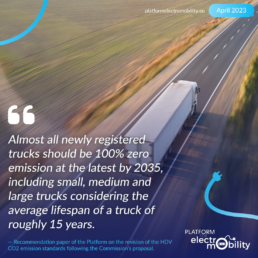
The proposal’s new definition of zero emission (5 gCO2/tkm) creates a dangerous loophole for continuous sales of emitting vehicles even after 2050. The current definition requires trucks to emit less than 1 gCO2/kWh. The change of definition in the proposal allows for dual-fuel trucks running on 10% polluting diesel to be called zero-emission. The Platform strongly advocates to further only truly clean and future proof technologies and reverse the definition of ‘zero-emission’, and asks to keep it as it is (1 gCO2/kWh)
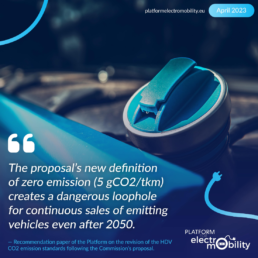
Sourcing should be both adequate and sustainable. The legislation should focus on ensuring an availability of supply that respects both human rights and environmental standards, regardless of the country of origin.
The global CO2 emission reduction targets for lorries as well as coaches should be significantly increased to align it with Europe’s 2030 climate target and market feasibility considering the sales targets by heady duty vehicle makers of up to 63% zero emission by 2030 . The proposed 2030 target of -45% is lacking ambition and is below what manufacturers have announced. It should be increased to an emission reduction level of at least 65%. An ambitious early target is key to breaking the cost barriers by unlocking rapidly improving battery technologies and by profiting from efficiency gains of ZEV series production.
The platform very much welcomes energy efficiency targets for trailers and semi- trailers as they will be a catalyst and accelerator for additional emission reductions.
An intermediary target should be included with a 70% ZEV mandate by 2027 considering that in 2022 30% of new buses in Europe were already zero emission , allowing city buses to move on a faster emission-free trajectory. As the bus target is counted towards the global CO2 emission reduction target, manufacturers have additional flexibility to reduce their emission by producing ZEVs in either of the categories – buses or coaches.
Two subcategories of urban buses, namely class II low-entry (i.e. 31L2 and 33L2), should be moved into the coach segment, as they are often used by local and regional authorities for longer distance public transportation. A usage that will be more difficult to decarbonize by 2030. In parallel, coaches, therefore including class II low-entry, should have the following CO2 reduction targets: 20% ZEVs by 2027, 60% by 2030 and 100% by 2035.
Policy makers need to create enabling conditions for transport operators and local and regional public authorities to transition to zero emission, such as sufficient funding opportunities for buses and infrastructure as well as assured grid reinforcements. In cases where recent investments into low-emission infrastructure have been made, an extended deployment of the existing bus fleets beyond their average lifetime can be made.
More clarity on the exemptions introduced by Article 3.b. would be needed as the content of the upcoming Delegated Act are not known yet and give the exemption a high level of unpredictability. The “maximum share of vehicles that a Member State can exclude” should be limited to the maximum level that does not jeopardize the strength and very meaning of the target. In addition, MS should strongly and objectively demonstrate and motivate the reasons for asking for the exclusions.
In order to help city councils and operators lower the cost of bus electrification, the best price-quality ratio criteria in the new public procurement procedures (article 3c) should include not only the provision of buses but also other services as the installation of the depots and on-road charging infrastructure and their operation and maintenance.
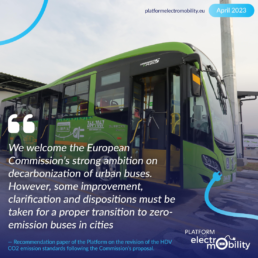
• The platform supports the Commission’s decision not to include a crediting mechanism for renewable and low-carbon fuels under this regulation. Under such a mechanism, manufacturers could continue to produce ICE vehicles and delay the transition to zero emission ones whilst not actually being able to control how fuels are being used in the end (and still being rewarded for it). In addition, incentivising these fuels are incompatible with EU efforts to increase efficiency and reduce energy consumption in HDVs.
• The ZLEV mechanism should be transformed into a ZEV only mechanism and as proposed phased out by 2030 when significant market ramp-up for zero emission trucks and buses can be expected.
• The possibility of transferring of zero-emission vehicles between non-connected manufacturers should be maintained. However, in order to create a large-enough market place for trading between manufacturers, co-legislators should remove the proposed 5% cap for receiving manufacturers.
• There should not be an exemption for small volume manufacturers as it is a contrary measure to reach carbon neutrality by 2050.
• The extension of the emission debts and crediting system from 2030 to 2040 gives additional flexibility to manufacturers to earn credits (when reducing emissions more than required) and use them to offset debts (if emissions are above what is required). Credits now can be used for 15 years to offset debts. Credit’s lifetime should have a maximum of 5 years as do the debts, have now. This would force to continuously investing in reducing their CO2 emissions.
• Protect the penalty scheme, which will force OEMs to take decarbonisation seriously. The currently existing excess CO2 emissions premium (penalty) should not be subject to the development of public infrastructure as many first-movers will aim for depot charging for their operations.
• Set a future-proof definition of long-range ZEHDVs. The European Commission proposed a threshold of 350 km as the definition for a long-range ZEHDVs. This should be increased to 450 km to accommodate the latest developments of improved battery designs that are offering longer ranges.
The ambitious charging infrastructure targets as finally adopted in the AFIR enabler a successful rollout of ZEVs. Additional private as well as public investments are needed to ensure higher grid capacity to serve the growing trucks and buses charging demand. The revenues from excess emission premiums should be channeled back into the sector for the roll out of the infrastructure network.
Investing in reskilling of workers is essential for both, those currently employed in the HDV manufacturing and therefore see a conversion of current skills, and new ones who will be increasingly specialized in new production value-chain. It can reduce social risk and increase labour resiliency. Other measures such as job-search assistance to jobseekers and income and early retirement support could make the transition more “just”.
The positive effects of electrifying trucks and buses are far-reaching and go beyond reducing Europe’s GHG emissions – accelerating the zero emission HDVs roll out also allows to drastically improve noise and air pollution. The high increase of energy efficiency in the case of BETs is particularly beneficial when road transport accounts for 29% of the EU’s final energy consumption[1]. The Platform for electromobility also wants to highlight that the transition to electric trucks and buses is a considerable opportunity for the European e-mobility value chain and the competitiveness of the economy. Ambitious targets would make Europe a leader in zero emission HDVs and thus further unlock the potential of the e-mobility value chain.
[1] https://theicct.org/transport-could-burn-up-the-eus-entire-carbon-budget/
Weight & Dimensions Directive: the hidden milestone for e-trucks
Six points to make the Weights & Dimensions Directive
better incentivize zero emission trucks and buses
The Heavy Duty Vehicle (HDV) segment needs to accelerate its decarbonisation. In 2022, battery electric heavy trucks made up only 0.6% of new truck registrations in Europe. Diesel represented 96.6%[1].
Buses are decarbonising much faster, as new urban bus sales in 2022 saw a higher share of zero emission vehicles – 30%. Diesel buses represented 67.3% of the new sales in Europe[2].
While the CO2 standards for trucks and buses are important in setting decarbonization targets for the HDV sector, they will not solve the issue of incentivizing Zero Emission (ZE) trucks and buses.
ZE trucks will be able to benefit from mandatory toll discounts under the Eurovignette directive and the expansion of ETS to road transport. Currently, ZE trucks benefit from a minimum tax on diesel, and a weight allowance of 2 tonnes more than a diesel truck. As zero emission vehicles weigh more than diesel-powered vehicles due e.g. to the battery weight, the additional weight allowance is a must-have measure for decarbonizing the HDV segment.
Even though the additional weight allowance of 2 tonnes is a good starting point, there are additional measures that can help the uptake of ZEHDVs, which has so far been limited. The proposed revision of the Weights & Dimensions Directive (WDD) provides an excellent opportunity for non-monetary incentives for zero emission trucks and buses in Europe. The European Commission should focus on the following measures:
- Implement clear cross-border rules
- Modify the methodology governing the additional weight allowance
- For long-range ZE trucks, permit one further tonne, linked to range, to a max of 3t
- Allow ZEHDVs a time-limited increase in the maximum authorised drive axle weight
- European Modular System (EMS) should be zero-emission by 2028
- Set explicit time limits for WDD transposition and type-approval

- Implement clear cross-border rules
As it stands now, the WDD enables the additional weight allowance only at border crossings of 13 EU Member States as the weight allowance only applies at borders of countries that have the lowest authorised vehicle weight. Furthermore, it does not provide an incentive for ZE HDV activities at the national level.
The current WDD has led to disputes between Member States on the allowed weight of HDVs on border crossings. In order to avoid any new disputes and remove the existing ones, the EC should develop rules that apply to the entire EU and not to selected border crossings.
The Benelux countries have done exactly that in 2022[3]. Although Benelux countries have different authorised weight allowances, when freight vehicles cross borders, the lowest weight limit in both countries is applicable. And for zero-emission vehicles, the additional weight allowance is automatically added.
Therefore, the European Commission should expand the scope of the WDD and clearly define that:
- The lowest authorised weight limit at border crossings is equal to the lowest authorised weight limit between two adjoining Member States;
- That the additional weight allowance for ZE HDVs is automatically added to the lower authorised weight limit;
- The additional weight allowance applies also for national transport.
- Modify the methodology governing the additional weight allowance
In practice, the current system requires the vehicle-maker to present a diesel comparator, with up to 2 additional tonnes then allowed above the weight of the comparator vehicle.
This system causes issues for new ZE vehicle-makers, which by definition, don’t have comparator vehicles to reference.
The WDD revision should grant some flexibility to new entrants by saying that the relevant authorities must have due regard to the position of new entrants in the selection and assessment of comparator vehicles.
- For long-range ZE trucks, permit one further tonne, linked to range, to a max of 3t
Up to ranges of approximately 400km, the additional 2t already granted is sufficient. Beyond this range, however, the allowance should be increased according to greater range provided. We suggest 2.5kg per km of ZE certified range above 400km to a maximum of 3t (i.e. the maximum is reached at 800km).
- Allow ZEHDVs a time-limited increase in the maximum authorised drive axle weight
The change most sought by truck and bus-makers is an increase in the maximum authorised axle weight placed on the axle connected to the zero emission powertrain, more commonly known as the drive axle. Today the weight limit applied to the drive axle is 11.5t, and due to the higher weight of ZE powertrains (e.g. batteries), truck and bus-makers ask that this limit be raised to 12t. This ask concerns two-axle tractor units and buses in the EU, which are the most-sold configurations.
On the one hand, such a change would boost the pace and scale at which zero-emission trucks and buses are deployed. On the other hand, without safeguards and phase-down dates, it could increase road wear.
Therefore, we advocate considering this change on the basis of a number of safeguards covering:
- tyre configuration and maintenance;
- the speed at which such vehicles can take off from a stopped position (“acceleration from rest”); and
- timeframe, namely that ZE truck & bus-makers can deploy 12t drive axles – under certain conditions – until a certain year (2029 for trucks).
Taking each of these in turn, for a qualifying vehicle, it would be necessary to deploy:
Tyres
- On the steer (front) axle, wide base high-efficiency tyres
- On the drive (rear) axle, dual tyre configuration (assembly) using high-efficiency tyres
- A Tyre Pressure Monitoring system that alerts the driver to a loss of pressure any greater than 0.5 bar, and with a duty to restore pressure to recommended levels at the nearest available facility having regard to the direction of travel
Acceleration limiter
- Ensuring take-off-from-rest is between 1 and 1.2m/s2
Timeframe
- 4×2 ZE trucks registered from entry into force [in ~2026] to 1.1.2029 can carry 12t on the drive axle – once the above conditions are met
- More flexibility on the end date could be considered for buses (and coaches) given their smaller sales numbers.
- European Modular System (EMS) should be zero-emission by 2028
There are calls across the trucking sector for more opportunities to use EMS. However, it can only be guaranteed that EMS will reduce emissions if the trucks are ZE. Therefore if proposals are made to permit cross border EMS, it can only be by ZE trucks, and where each route is checked and approved by the relevant authorities for road safety (i.e. that approach roads used to access the highway are suitable for EMS movement) and freight modality (coherence with overall freight policy goals).
- Set explicit time limits for WDD transposition and type-approval
The WDD does not have a formal time limit for transposing the existing 2 tonnes weight allowance into national law. This needs to be done as soon as possible as the business case for long-range zero emission HDVs depends on clear rules across Member States.
As the previous transposition of weights and dimensions rules to type approval law took four years, it is important to set a stricter deadline. This will enable manufacturers to achieve the recently proposed HDV CO2 reduction targets.
